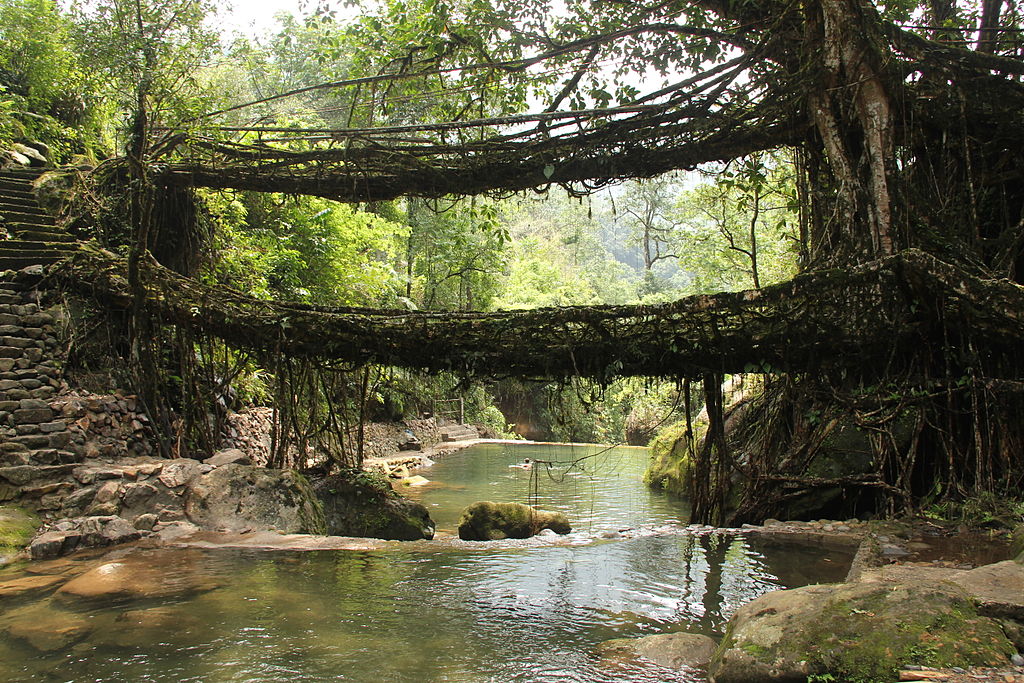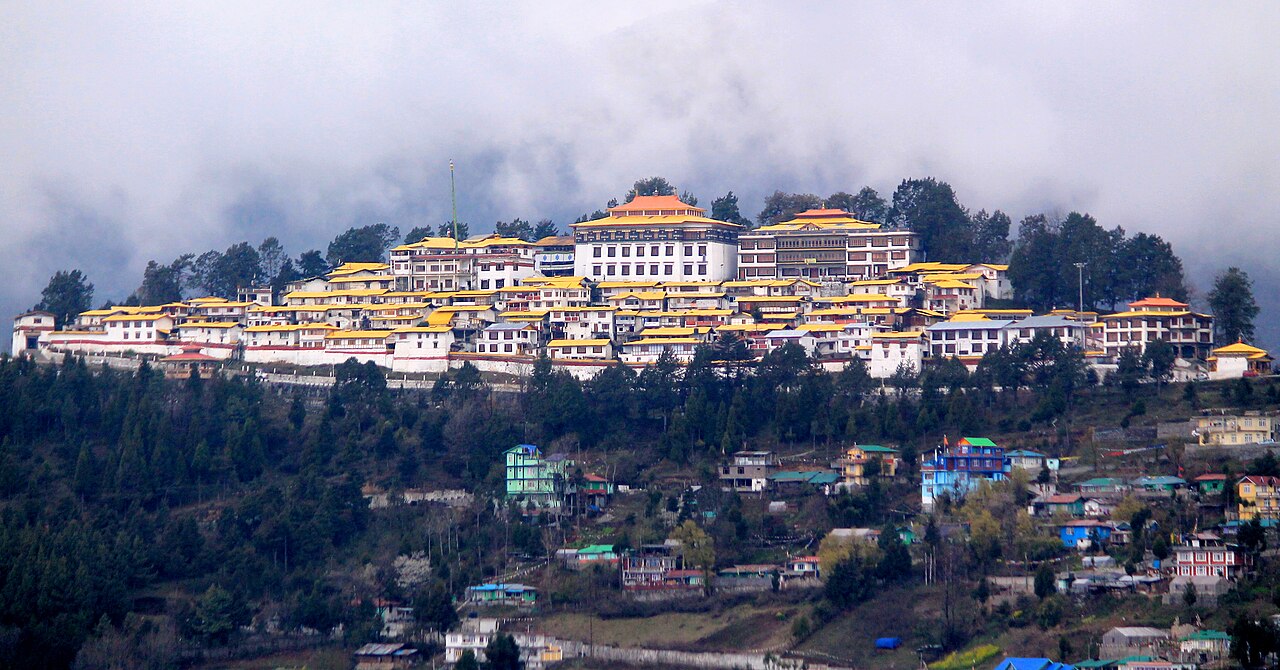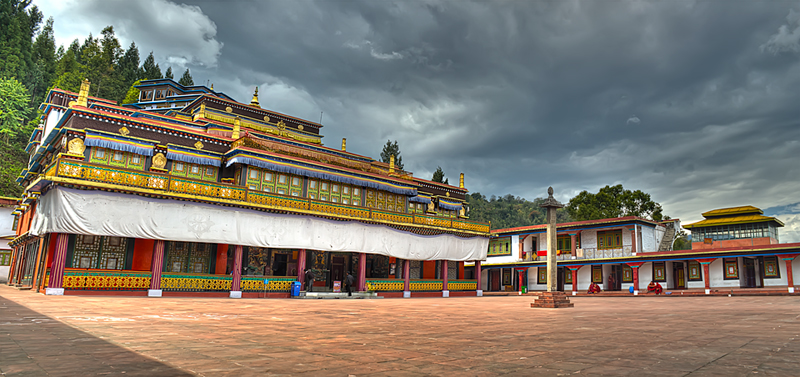
If you’re planning your first trip to North East India, here’s a complete travel guide covering the best destinations, suggested itinerary, transportation, stay options, and safety tips.
Top Places to Visit in North East India
1. Assam
-
Must Visit:

Kaziranga National Park: Home to the one-horned rhinoceros, elephant safaris, birdwatching.
-
-
Majuli: World’s largest river island on the Brahmaputra; famous for satras (Vaishnavite monasteries).
-
Sivasagar: Former Ahom kingdom capital with Rang Ghar, Talatal Ghar, and ancient tanks.
-
Kamakhya Temple: A powerful Shakti Peeth in Guwahati.
-

-
Who Should Visit: Wildlife lovers, history buffs, spiritual seekers.
-
Tips: Visit Kaziranga from November–April (park closed in monsoon). Stay in eco-lodges near the park or riverside hotels in Guwahati.
2. Meghalaya

-
Must Visit:
-
Shillong: Music cafes, Ward’s Lake, Don Bosco Museum, Elephant Falls.
-
Cherrapunji (Sohra): 
 Nohkalikai Falls, Seven Sisters Falls, Mawsmai Cave, Double Decker Living Root Bridge trek. 
Nohkalikai Falls, Seven Sisters Falls, Mawsmai Cave, Double Decker Living Root Bridge trek. 
-
Mawsynram: Wettest place on earth, green landscapes, caves.
-
Dawki & Shnongpdeng: Crystal-clear Umngot River boating and camping.
-
-
Who Should Visit: Adventure seekers, nature photographers, couples.
-
Tips: Stay at Police Bazar (central) or eco-resorts in Sohra. Carry rain gear even in winter.
3. Arunachal Pradesh
-
Must Visit:
-
Tawang: Tawang Monastery (2nd largest in the world), Sela Pass, Bum La Pass (near Indo-China border). 

-
Ziro Valley: UNESCO tentative site, known for Apatani tribal culture, rice fields, Ziro Music Festival (Sept/Oct). 

-
Namdapha National Park: One of India’s richest biodiversity zones, tigers, leopards, clouded leopards.
-
Itanagar: Ita Fort, Ganga Lake, Buddhist monastery.
-
-
Who Should Visit: Mountain trekkers, cultural explorers, photographers.
-
Tips: ILP required. Best season is Oct–April. Weather gets extremely cold in winter (sub-zero at Tawang).
4. Nagaland
-
Must Visit:
-
Kohima: WWII Cemetery, State Museum, Kisama Heritage Village. 

-
Dzukou Valley: “Valley of Flowers of the East” – best for trekking (June–Sept for blooms). 

-
Hornbill Festival (Dec 1–10): 16 Naga tribes showcase music, dance, food, and traditions.

-
-
Who Should Visit: Culture lovers, trekkers, festival travelers.
-
Tips: ILP required. Stay in homestays or festival camps during Hornbill.
5. Manipur
-
Must Visit:
-
Loktak Lake: Phumdis (floating islands), Sendra Island, boating. 

-
Imphal: Kangla Fort, Ima Keithel (women-run market), Manipur State Museum. 

-
Ukhrul: Shirui Lily blooms (May–June), green valleys.
-
-
Who Should Visit: Offbeat explorers, eco-tourists, peace seekers.
-
Tips: Good road connections from Imphal. Stay near Loktak for sunrise views.
6. Mizoram
-
Must Visit:
-
Aizawl: Durtlang Hills view, Solomon’s Temple, local handloom market. 

-
Vantawng Falls: Tallest waterfall in Mizoram surrounded by forest. 

-
Blue Mountain (Phawngpui): Sacred peak, rich in orchids and birdlife. 

-
-
Who Should Visit: Nature lovers, slow travelers.
-
Tips: ILP required. Try Mizo cuisine – bai (veg stew), sticky rice, smoked pork.
7. Tripura
-
Must Visit:
-
Agartala: Ujjayanta Palace, Heritage Park. 

-
Park. : Lake palace, boat rides.
-
Unakoti: Rock-cut sculptures of Shiva, famous pilgrimage site. 

-
Sepahijala Sanctuary: Clouded leopards, birds.
-
-
Who Should Visit: History & architecture lovers, short-trip travelers.
-
Tips: Compact state, can be explored in 3–4 days. Best to stay in Agartala.
8. Sikkim (The Brother State)
-
Must Visit:
-
Gangtok: MG Marg, cable car, monasteries. 

-
-
-

-
Lachung & Yumthang Valley: “Valley of Flowers”, hot springs. 

-
Gurudongmar Lake: Sacred high-altitude lake (17,800 ft). 

-
Pelling: Kanchenjunga views, Pemayangtse Monastery, Rabdentse ruins. 

-
Nathula Pass: Indo-China border (closed Mondays, permits required). 

-
-
Who Should Visit: Honeymooners, adventure travelers, spiritual seekers.
-
Tips: Avoid monsoon (landslides). Stay in Gangtok (central base) and Pelling for views.
Suggested Itinerary for North East India (10–12 Days)
Day 1-2: Guwahati (Kamakhya Temple, Brahmaputra River Cruise, Kaziranga Safari)
Day 3-5: Shillong & Cherrapunji (Living Root Bridge, Dawki, Nohkalikai Falls)
Day 6-7: Tawang (via Sela Pass, visit Tawang Monastery, Bum La Pass)
Day 8-9: Ziro Valley (tribal villages, rice fields, local homestays)
Day 10-11: Nagaland (Kohima, Hornbill Festival if in December, Dzukou Valley trek)
Day 12: Return to Guwahati / fly out
👉 If you have more time, extend to Manipur’s Loktak Lake and Sikkim’s Gangtok–Lachung circuit.
Best Areas to Stay
-
Guwahati: Paltan Bazar (budget), Uzan Bazar (boutique & riverside)
-
Shillong: Police Bazar (central, good for shopping), Laitumkhrah (quiet, cafes)
-
Cherrapunji: Sohra village homestays or eco-lodges
-
Tawang: Near Tawang Monastery or market area for easy access
-
Ziro Valley: Local homestays with Apatani tribes
-
Gangtok (Sikkim): MG Marg (central, well-connected)
Transportation in North East India
-
Air: Major airports in Guwahati, Imphal, Dibrugarh, Bagdogra (Sikkim), and Aizawl.
-
Rail: Guwahati is the main hub; trains connect to Delhi, Kolkata, Bangalore, and other metros.
-
Road: Shared sumos, taxis, and buses are common. National highways are improving but mountain roads can be slow.
-
Inner Line Permit (ILP): Required for Arunachal Pradesh, Nagaland, and Mizoram (can be obtained online).
🛡 Safety in North East India & Tourist-Friendly States
North East India is considered one of the safest regions in the country for travelers. The people are warm, helpful, and respectful towards visitors. Solo travelers, especially women, find the region more comfortable compared to many other parts of India.
-
Tourist-Friendly States:
-
Meghalaya & Sikkim – Very popular with domestic and international tourists; easy permits, good infrastructure, and friendly locals.
-
Assam – Well-connected, with major attractions like Kaziranga and Majuli.
-
Nagaland & Arunachal Pradesh – Increasingly popular among culture and adventure seekers, though permits (ILP) are required.
-
-
Travel Precautions:
-
Avoid remote travel at night.
-
Always carry some cash as ATMs may be limited in villages.
-
Respect tribal customs and ask before taking photos.
-
Keep offline maps for areas with weak mobile signals.
-
Tourist Permits in North East India
Traveling in the North East is slightly different from the rest of India because some states require special permits for entry, especially for foreign nationals. Here’s a breakdown:
✅ States Without Special Permits
-
Assam – No permit required (for both Indians & foreigners).
-
Meghalaya – No permit required.
-
Tripura – No permit required (except some sensitive border/tribal areas).
-
Manipur – No permit required for Indians; foreigners must register at the airport or land entry points.
✅States Requiring Inner Line Permit (ILP) for Indians
(ILP is issued by the respective state government and can often be applied for online.)
-
Arunachal Pradesh – ILP required for all Indians; foreigners need a Protected Area Permit (PAP).
-
Nagaland – ILP required for Indians; foreigners must register with the local police on arrival.
-
Mizoram – ILP required for Indians; foreigners need to register but no permit required.
-
Sikkim (technically Northeast-adjacent) – No ILP for main areas, but certain zones (like Nathu La, North Sikkim) require special permits for both Indians and foreigners.
🔹 For Foreign Tourists
-
Protected Area Permit (PAP) is required for Arunachal Pradesh and some border areas of Sikkim.
-
Nagaland, Manipur, Mizoram – No PAP now, but foreigners must register with the Foreigner Registration Office (FRO) or local police within 24 hours.
-
Tripura, Assam, Meghalaya – No special permit required.
📍 Quick Tip
-
ILP can often be applied online (for Arunachal, Nagaland, Mizoram, Sikkim).
-
Always carry multiple photocopies of your ID and permits, as they are often checked at army or police checkpoints.
Final Thoughts
North East India is more than just a destination – it’s an experience of diverse cultures, unexplored beauty, and soulful journeys. Whether you’re cruising the Brahmaputra, trekking through root bridges, or meditating in ancient monasteries, this part of India will stay with you forever.
✈️ Ready to explore the unexplored? Pack your bags and let North East India surprise you with its magic.
Get best deals on hotels & hostels on Tournami.com.
Recent Posts
- Best Dubai Hotels & Resorts for Couples – Luxury & Romance in One Stay
- Where to Celebrate New Year 2025 in India – Ultimate Party Guide
- Best Romantic Resorts in Dehradun for Couples | Luxury & Nature Escapes
- Ultimate Guide to the Best National Parks in the USA for Adventure Travelers
- Malta Travel Secrets – Famous Spots & Hidden Local Favorites
- Best Hotels in Malta Guide – Compare Amenities, Features & Prices
- Your Ultimate Guide to Oktoberfest: Food, Beer & Activities
